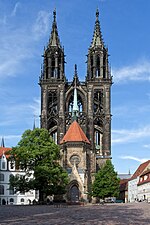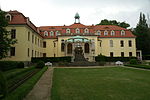Sächsisches Landesgymnasium Sankt Afra zu Meißen

Sächsisches Landesgymnasium Sankt Afra zu Meißen is a boarding school for highly gifted students in the German city of Meissen, Saxony. Founded in 1543 as Fürstliche Landesschule and re-established in 2001, the stated aim of the school is to promote the intellectual and social development of highly gifted students. The costs for attending the school comply with the maxim of social balance; the boarding and schooling fees are considerably low in contrast to similar institutions. It is the first publicly funded school for highly gifted students in Germany and is a role model for similar schools. The school has no official English name. Its German name translates to "Saxon State Gymnasium Saint Afra in Meissen", and is derived from the former Augustinian monastery of the Canons Regular that had been built around the local Saint Afra church.
Excerpt from the Wikipedia article Sächsisches Landesgymnasium Sankt Afra zu Meißen (License: CC BY-SA 3.0, Authors, Images).Sächsisches Landesgymnasium Sankt Afra zu Meißen
Freiheit,
Geographical coordinates (GPS) Address Nearby Places Show on map
Geographical coordinates (GPS)
| Latitude | Longitude |
|---|---|
| N 51.163888888889 ° | E 13.468055555556 ° |
Address
Landesgymnasium St. Afra zu Meißen (Landesgymnasium Sankt Afra)
Freiheit 13
01662 , Niedermeisa
Saxony, Germany
Open on Google Maps








